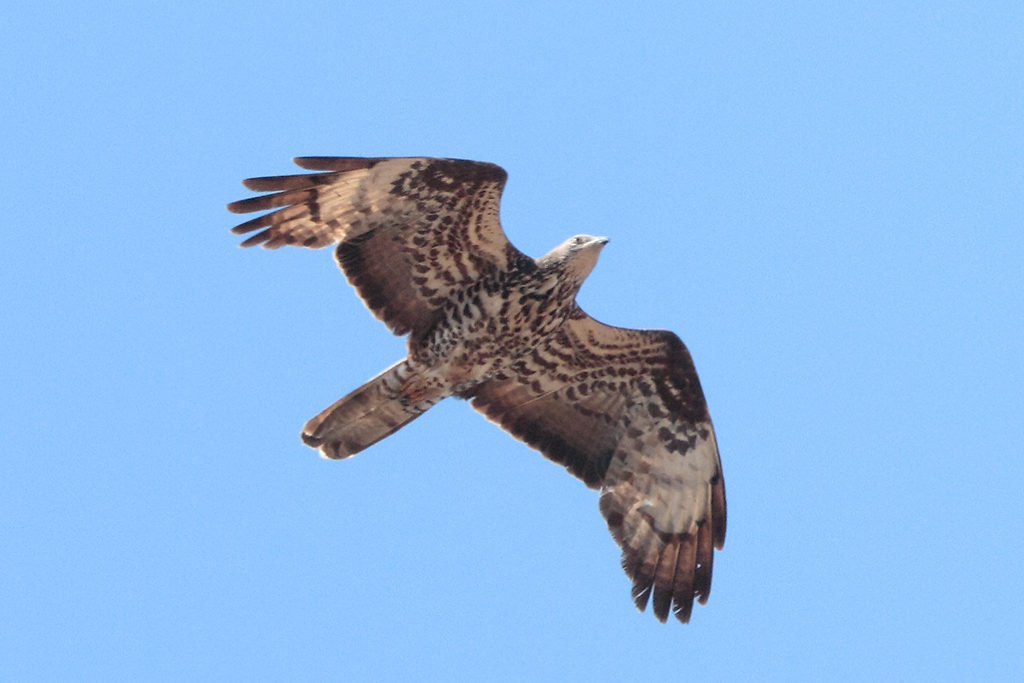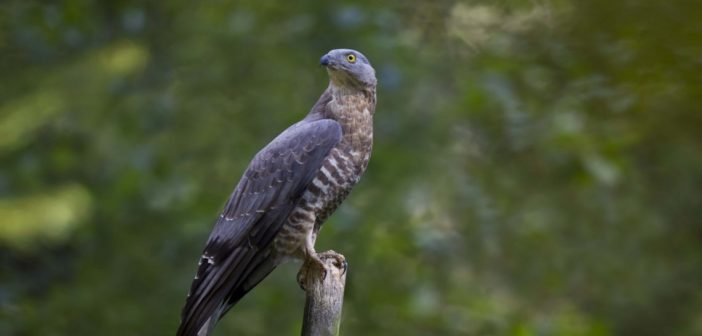Written by Jessica Law
The European honey-buzzard (Pernis apivorus) is a bird of contradictions. Despite their sugary name, they don’t eat honey. Their main food isn’t even bees; they rely more on the larvae of wasps and hornets. Shifting up and down their perch and bobbing their head from side to side, they use their needle-sharp vision to spot the stinging insects and follow them back to their nest. Here, they unsheath their long talons, disembowel the nest and often carry it whole to the forest floor to plunder it further.
European honey-buzzards have some fascinating adaptations which allow them to nonchalantly shrug off a barrage of stings. A natural armour of scale-like feathers protects their heads, and they are also thought to have a chemical deterrent coating their plumage. It’s a tough lifestyle, but no other birds do it – in fact, they are the only known predator of the Asian giant hornet.
Watch a honey-buzzard in action in the above video.
But their diet isn’t the only contradiction. European honey-buzzards aren’t true buzzards, either; they’re actually more closely related to kites. The similarity of their plumage to the Eurasian buzzard (Buteo buteo), especially in juveniles, is instead thought to be an intriguing case of mimicry. In order to ward off the predatory northern goshawk (Accipiter gentilis), the European honey-buzzard may ape the appearance of a stronger, tougher species.
The final contradiction comes from the “European” part of its name, since the species doesn’t stick to just one continent. Instead, they overwinter in tropical Africa, making their way to Europe to breed. On migration, this usually solitary species flocks together, using the earth’s magnetic field to orientate themselves– supplemented by an incredible visual memory for landmarks and the ability to take advantage of winds. Like the white stork (Ciconia ciconia), they divert around the Mediterranean Sea, which does not create thermals suitable to glide on. Instead, flocks funnel themselves over the narrowest sea crossings, such as the Gibraltar Strait and the Messina Strait.
It is here that they become easy targets for poachers, who shoot down staggering quantities of migrating birds for fun. The Messina Strait, on the southern tip of Italy, was once one of Europe’s worst “blackspots” for the illegal killing of raptors. In fact, as many as 5,000 Eurasian honey-buzzards were unlawfully killed there every year. But back in the 1980s, something incredible started happening.
LIPU (Lega Italiana Protezione Uccelli, BirdLife in Italy) had the innovative idea to hold “anti-poaching camps,” whereby volunteers from all over the world would travel to the area to keep watch over the migrating birds. Their presence alone deterred many poachers, but volunteers were also quick to report any illegal killing incidents they witnessed, aided by the National Forestry Corps. The first years were intense, with threats, physical aggression, shooting to police vehicles and helicopters, and even a bomb destroying LIPU’s local office, but eventually the continued effort to fight unlawful activity paid off.

An adult female European honey-buzzard, seen in Slovakia. Image credit Radovan Václav, CC BY-SA 3.0.
Thirty years later, they are still going, but they’ve brought in others, too. Over the years, the presence of the camps has changed local attitudes, and now members of the community work alongside volunteers to protect the birds that pass through their area. Furthermore, LIPU and their volunteers have developed a monitoring network that provides the police with advanced information on where the ‘waves’ of raptors will be landing, allowing them to be present in the right places at the right time.
The result has been extraordinary. The number of honey-buzzard casualties per year have gone from 5,000 to only 100, and it has been estimated that at least 85,000 European honey-buzzards would have died over the past three decades if poaching had not been addressed.
It’s an inspiring tale of hope, showcasing the power of collaboration – but the story hasn’t ended yet. Across the rest of Italy, illegal shooting is still rife. LIPU is now looking outwards, planning to expand this success to tackle the illegal shooting and trapping of Eurasian skylarks (Alauda arvensis) and quails in Puglia, or the unlawful trapping of Eurasian blackcaps (Sylvia atricapilla) in Sardinia. There are also plans to support local livelihoods by promoting this area as a birding tourism destination. We’ve seen what’s possible, and we know we can give other species the sweet taste of success.
The European honey-buzzard is one of seven flagship birds in our Flight for Survival campaign to raise awareness of the scope and scale of the illegal killing of migratory birds.
Featured image: a European honey-buzzard. Image via Birdlife.





